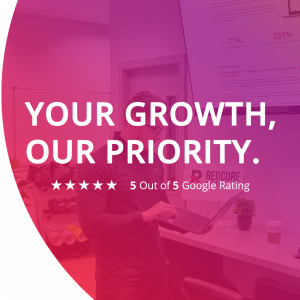One possible effective way of rebuilding your business after the COVID-19 pandemic is over is by building a digital marketing strategy. This applies to both brick-and-mortar businesses such as restaurants, and online businesses like streaming sites.
Very few businesses are unaffected by COVID-19. Even the largest corporations are affected as demand for their goods and services has declined, particularly those companies that do not produce essential products. We are facing an economic recession on a global scale.
In This Post
Adapting to the new “Normal”
Some small and medium enterprises that rely on a daily influx of customers to their establishments, like bars, hairdressers, and gyms, may have great difficulty recovering, and we don’t even know at the time of writing when the end will be in sight.
Building a digital marketing strategy can help businesses reach out to their target audience. Even during the lockdown, some businesses have shifted to work-from-home arrangements. High reliance on online tools will definitely be part of the new normal.
How has the digital marketing landscape has changed during COVID-19?
The COVID-19 pandemic has drastically affected the global economy, slowing it down as nation-states closed their borders and implemented lockdowns. It may seem that digital and internet-based businesses have not been as strongly affected, but the pandemic has presented both boon and bane for the digital landscape.
Any marketing strategy must be able to adapt to changes in digital trends and consumer behaviour online. It’s undeniable that online activity has significantly increased because of the pandemic. These include remote working arrangements and overall digital consumption as people are out of work and constantly at home.
Some Positives
- Increase in paid video streaming consumption. The pandemic is a boon for some content-based businesses, particularly for movie streaming websites like Netflix. The stock prices of some content-based businesses have increased as the subscriptions and potential profitability also increased.
- Increase in social media use. As people become physically isolated from friends, loved ones, relatives, and society in general, they turn to social media for comfort. Social media allows people to be socially active, communicating and engaging with other people.
- Increase in game downloads and online gaming. Computer games and online gaming are forms of entertainment that are traditionally very popular among younger people, particularly teenagers and young adults. However, the lockdown has prompted a wider demographic to start gaming.
- Growth in the telecommuting sector. Many people have to work from home. As a result, demand is high for online tools like teleconference platforms and real-time collaboration platforms. Companies providing these platforms and SaaS support are likely to benefit. Even some health clinics are now offering consultations online.
- Rise of cashless transactions. Online shopping and credit card use is likely to increase during the lockdown and during the new normal after the lockdowns.
The Negatives
- Disruption of the supply chain in telecom. As the pandemic rages on, the crucial supply chains for telecommunication and electronic companies are disrupted. Partial or full shutdown in mining operations for crucial mineral ores like lithium, cobalt, copper, and gold have affected the production of mobile devices. Some electronics manufacturers have also temporarily closed.
- Big tech conferences are likely to be cancelled or rescheduled. Some of the largest international and national tech business conferences were already cancelled. The Mobile World Congress (MWC) scheduled in February this year in Barcelona was cancelled, and others scheduled in the next few months are likely to be cancelled as well. Opportunities for growth and new partnerships will be missed.
- Total ad spending is likely to significantly reduce. As many companies close shop, including online companies, the demand for digital ads will also decrease. This in itself could be a reason to get your digital marketing plans in order right now.
Using digital marketing to rebuild your business
You can use digital marketing as a strategy to rebuild your business. You can adapt to the new normal by using online options such as:
- Using social media to reach out to your customers or clients
- Building a website that provides detailed information and serves as your store
- Subscribing to paid ads to target a specific market
Rebuilding a business after a major economic recession can be difficult, especially for many small and medium enterprises that suffered closures for extended periods of time during the pandemic. Some factors that need to be addressed are the following:
- Financial solvency – many businesses that closed during the lockdowns may have issues paying their debts and getting additional loans to finance the reopening of their businesses.
- Winning back customers – lockdowns have made many people unemployed, losing their purchasing power. This will affect the overall demand for certain products and services.
- Innovative and competitive offers – competition might become relatively low for those businesses that are able to reopen. However, the needs and wants of your target customers might have already changed.
How to build a digital marketing strategy
Be clear about your focus
Building a digital marketing strategy should always be based on industry best practice. It should also be highly responsive to the demands and needs of your target market. You must also consider the following questions:
- Are you trying to generate brand awareness?
- Do you want to win back former clients or customers after a long hiatus?
- Is expansion to new territories such as introducing new products your main focus?
- Do you want to establish a good reputation and encourage customer loyalty?
- Do you want to highlight your competitive advantage?
If you can clearly answer these questions, your main objective and focus will also be clear. This will serve as the foundation for your digital marketing strategy.
Set quantifiable and realistic milestones
Once your focus is established, you can then set goals that need to be achieved to determine levels of success. You should follow SMART goal setting guidelines:
- Specific
- Measurable
- Attainable
- Relevant
- Time-Based
For example, you may want to achieve 1,000 new leads within one month for your website. It is specific, measurable, and time-based in terms of email signups but is it attainable? The answer will depend on how you plan to achieve this milestone. Here is a great guide to settings Goals from Creately.com.
Choose the right approach and tools for your needs
You may want to use both SEO techniques and paid ads to leverage targeted PPC. You might also want to try email marketing or perhaps have freemium offers to attract potential subscribers.
If you have limited time, budget and manpower, you could just use one approach at a time. For example, if your main focus is establishing a brand, you may use social media to interact and engage with your target audience.
Refine your tactics
If one tactic or set of tactics do not work well as expected, refine your approach. You should not be held down by just one approach. That way you can significantly improve your overall strategy in the long run. It does not have to be anything radical. Sometimes it may only need a simple tweaking. For instance, if you are using targeted ads on social media, you might try changing the parameters like demographics, location, and duration of the ads.
Need help with your digital marketing strategy? Book a Discovery Call With Us Today









